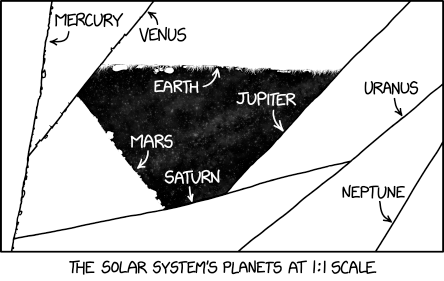1-to-1 Scale

There's a version that shows the planets with no cropping, but it's hard to find a display that supports it.

There's a version that shows the planets with no cropping, but it's hard to find a display that supports it.
This comic is implied to be a part of a huge diagram that shows each of the eight planets at real size (as seen by the ant on Earth's surface). Each planet is represented by a circle thousands of kilometers in diameter. However, the planets have been awkwardly placed in an extremely tight circle, so that all eight planets touch (or nearly touch) a tiny central area of "space" a few inches large. This comic shows a fraction of this diagram, cropped so that we see this area of "space" and a little of the edge of each planet intentionally arranged next to it.
The joke of this comic appears to be that when planets are indeed displayed at a 1:1 scale, it is almost impossible to tell their relative sizes, even when the image technically shows (part of) each of the planets.
The reason why each planet's circular border appears straight is because it's such a small area of each planet: you're only seeing a couple of square inches of the surface of each of the planets, and even though they are all round, the curvature would be imperceptible on this scale. The four gas giants are completely smooth, whereas the four rocky planets display features, most notably on Earth where grass and an ant are visible.
That it cannot have been an image of the real planets aligning is clear, as Mercury can be shown to be in front of Jupiter (implying that the latter is in the part of its orbit on the far side of the Sun from the viewer), yet Jupiter obscures Earth (which necessitates that it be in the arc of orbit nearest any given observer). In other words, there is no possible real alignment of the planets in which Jupiter passes between Mercury and Earth. In the title text it is made clear that this is just a small part of a larger drawing, so this is not an image taken from far away – they are only placed this way for scale.
The title text remarks that it is hard to find a display that supports a version of the image without cropping. This is because a true 1:1 scale image showing all of the planets would be at least as big as the largest one, Jupiter – far larger than any monitor or display currently available[citation needed] – or perhaps even big enough to hold Saturn's rings, in whatever orientation they lie. Furthermore, the amount of video memory that a graphics card would need to have in order to output at anywhere near the same DPI to such a display, even as a 1-bit-per-pixel-image (i.e., all pixels are either black or white), is well beyond the capabilities of any graphic card that existed at the time of publication.[citation needed]